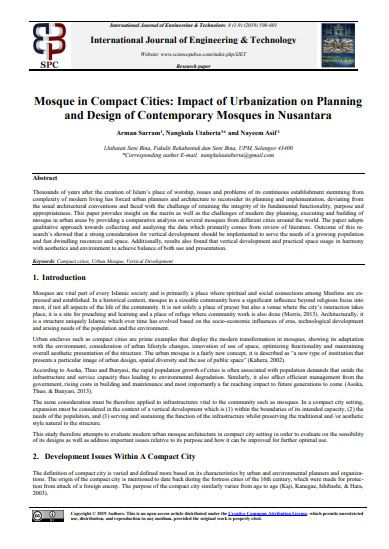
Thousands of years after the creation of Islam’s place of worship, issues and problems of its continuous establishment stemming from complexity of modern living has forced urban planners and architecture to reconsider its planning and implementation, deviating from the usual architectural conventions and faced with the challenge of retaining the integrity of its fundamental functionality, purpose and appropriateness. This paper provides insight on the merits as well as the challenges of modern day planning, executing and building of mosque in urban areas by providing a comparative analysis on several mosques from different cities around the world. The paper adopts qualitative approach towards collecting and analyzing the data which primarily comes from review of literature. Outcome of this re-search’s showed that a strong consideration for vertical development should be implemented to serve the needs of a growing population and fast dwindling resources and space. Additionally, results also found that vertical development and practical space usage in harmony with aesthetics and environment to achieve balance of both use and presentation.
Sarram, Arman, Nangkula Utaberta, and Nayeem Asif. “Mosque in compact cities: Impact of urbanization on planning and design of contemporary mosques in Nusantara.” International Journal of Engineering & Technology 8, no. 1.9 (2019): 598-601.
I agree to the terms outlined below:
You agree to upload and assign Mosqpedia Database the rights to use the content worldwide and in perpetuity across all current and future media platforms. Mosqpedia Database may edit, copy, adapt and translate your contribution.
The content will be distributed under the Creative Commons Attribution-Deed – Attribution-NonCommercial-NoDerivatives 4.0 International – Creative Commons
All data will be stored in line with data protection regulations.